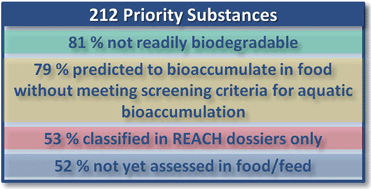当前位置:
X-MOL 学术
›
Environ. Sci.: Processes Impacts
›
论文详情
Our official English website, www.x-mol.net, welcomes your feedback! (Note: you will need to create a separate account there.)
Potential emerging chemical risks in the food chain associated with substances registered under REACH.
Environmental Science: Processes & Impacts ( IF 5.5 ) Pub Date : 2019-12-02 , DOI: 10.1039/c9em00369j J Oltmanns 1 , O Licht 2 , M-L Bohlen 1 , M Schwarz 1 , S E Escher 2 , V Silano 3 , M MacLeod 3 , H P J M Noteborn 3 , G E N Kass 4 , C Merten 4
Environmental Science: Processes & Impacts ( IF 5.5 ) Pub Date : 2019-12-02 , DOI: 10.1039/c9em00369j J Oltmanns 1 , O Licht 2 , M-L Bohlen 1 , M Schwarz 1 , S E Escher 2 , V Silano 3 , M MacLeod 3 , H P J M Noteborn 3 , G E N Kass 4 , C Merten 4
Affiliation

|
A screening procedure for the identification of potential emerging chemical risks in the food and feed chain developed in a previous EFSA-sponsored pilot study was applied to 15021 substances registered under the REACH Regulation at the time of evaluation. Eligible substances were selected from this dataset by excluding (a) intermediates handled under strictly controlled conditions, (b) substances lacking crucial input data and (c) compounds considered to be outside the applicability domain of the models used. Selection of eligible substances resulted in a considerable reduction to 2336 substances. These substances were assessed and scored for environmental release (tonnage and use information from REACH registration dossiers), biodegradation (predictions from BIOWIN models 3, 5 and 6 evaluated in a battery approach), bioaccumulation in food/feed (ACC-HUMANsteady modelling) and chronic human health hazards (classification according to the CLP Regulation for carcinogenicity, mutagenicity, reproductive toxicity and repeated dose toxicity as well as IARC classification for carcinogenicity). Prioritisation based on the scores assigned and additional data curation steps identified 212 substances that are considered potential emerging risks in the food chain. Overall, 53% of these substances were prioritised due to chronic hazards identified in REACH registrations dossiers only (i.e. hazards not identified in classifications from other sources). Bioaccumulation in food and feed predicted on the basis of ACC-HUMANsteady modelling identified many substances that are not considered bioaccumulative in aquatic or terrestrial organisms based on screening criteria of the relevant ECHA guidance documents. Furthermore, 52% of the priority substances have not yet been assessed for their presence in food/feed by EU regulatory agencies. This finding and illustrative examples suggest that the screening procedure identified substances that have the potential to be emerging chemical risks in the food chain. Future research should investigate whether they actually represent emerging chemical risks as defined in EFSA's mandate.
中文翻译:

与REACH所注册物质相关的食物链中潜在的新兴化学风险。
在评估时,由EFSA先前资助的一项前期研究开发的筛查程序可用于识别食品和饲料链中潜在的潜在化学风险,该程序适用于根据REACH法规注册的15021种物质。通过排除(a)在严格控制的条件下处理的中间体,(b)缺乏关键输入数据的物质和(c)被认为在所用模型的适用范围之外的化合物,从此数据集中选择了合格的物质。选择符合条件的物质后,大量减少到2336种物质。对这些物质进行了评估并评分,包括环境释放(REACH注册卷宗的吨位和使用信息),生物降解(通过电池方法评估的BIOWIN模型3、5和6的预测),食物/饲料中的生物蓄积性(ACC-HUMAN稳态模型)和慢性人类健康危害(根据CLP致癌性,致突变性,生殖毒性和重复剂量毒性法规进行分类,以及IARC致癌性分类)。根据分配的分数和其他数据整理步骤确定优先级,确定了212种物质,这些物质被认为是食物链中潜在的潜在风险。总体而言,由于仅在REACH注册卷宗中确定的慢性危害(即未在其他来源的分类中标识的危害),因此优先考虑了这些物质的53%。根据ACC-HUMANsteady模型预测的食品和饲料中的生物蓄积性,根据ECHA相关指导文件的筛选标准,确定了许多在水生或陆生生物中不具有生物蓄积性的物质。此外,欧盟监管机构尚未评估52%的优先物质在食品/饲料中的存在。这一发现和说明性实例表明,筛选程序已鉴定出可能在食物链中出现新化学风险的物质。未来的研究应调查它们是否真正代表了EFSA任务中定义的新兴化学风险。这一发现和说明性实例表明,筛选程序已鉴定出可能在食物链中出现新化学风险的物质。未来的研究应调查它们是否真正代表了EFSA任务中定义的新兴化学风险。这一发现和说明性实例表明,筛选程序已鉴定出可能在食物链中出现新化学风险的物质。未来的研究应调查它们是否真正代表了EFSA任务中定义的新兴化学风险。
更新日期:2020-02-13
中文翻译:

与REACH所注册物质相关的食物链中潜在的新兴化学风险。
在评估时,由EFSA先前资助的一项前期研究开发的筛查程序可用于识别食品和饲料链中潜在的潜在化学风险,该程序适用于根据REACH法规注册的15021种物质。通过排除(a)在严格控制的条件下处理的中间体,(b)缺乏关键输入数据的物质和(c)被认为在所用模型的适用范围之外的化合物,从此数据集中选择了合格的物质。选择符合条件的物质后,大量减少到2336种物质。对这些物质进行了评估并评分,包括环境释放(REACH注册卷宗的吨位和使用信息),生物降解(通过电池方法评估的BIOWIN模型3、5和6的预测),食物/饲料中的生物蓄积性(ACC-HUMAN稳态模型)和慢性人类健康危害(根据CLP致癌性,致突变性,生殖毒性和重复剂量毒性法规进行分类,以及IARC致癌性分类)。根据分配的分数和其他数据整理步骤确定优先级,确定了212种物质,这些物质被认为是食物链中潜在的潜在风险。总体而言,由于仅在REACH注册卷宗中确定的慢性危害(即未在其他来源的分类中标识的危害),因此优先考虑了这些物质的53%。根据ACC-HUMANsteady模型预测的食品和饲料中的生物蓄积性,根据ECHA相关指导文件的筛选标准,确定了许多在水生或陆生生物中不具有生物蓄积性的物质。此外,欧盟监管机构尚未评估52%的优先物质在食品/饲料中的存在。这一发现和说明性实例表明,筛选程序已鉴定出可能在食物链中出现新化学风险的物质。未来的研究应调查它们是否真正代表了EFSA任务中定义的新兴化学风险。这一发现和说明性实例表明,筛选程序已鉴定出可能在食物链中出现新化学风险的物质。未来的研究应调查它们是否真正代表了EFSA任务中定义的新兴化学风险。这一发现和说明性实例表明,筛选程序已鉴定出可能在食物链中出现新化学风险的物质。未来的研究应调查它们是否真正代表了EFSA任务中定义的新兴化学风险。


























 京公网安备 11010802027423号
京公网安备 11010802027423号